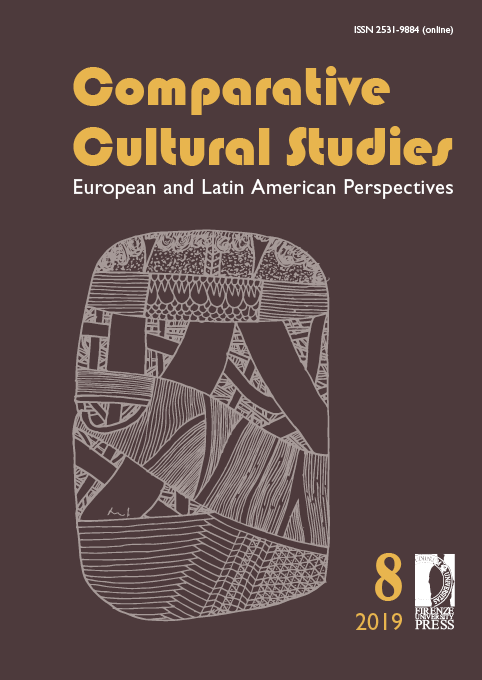Descortesía, agresión y violencia verbal en tres sitios de noticias en Facebook. Opiniones en torno al discurso discriminatorio
DOI:
https://doi.org/10.13128/ccselap-10864Palavras-chave:
Impoliteness, aggressiveness and verbal violence, discrimination, FacebookResumo
Among the most important characteristics in the study of the opposite pole of politeness is, according to Blas Arroyo (2010), the observation that both the character and degree of impoliteness behavior in interpersonal relationships are closely related to the contexts in which they operate, whether they are individual, cultural or institutional. The aim of this paper is to analyze impoliteness in virtual contexts with special reference to aggressive, violent and discriminatory discourse that appears in three news sites on Facebook. For the analysis of the impoliteness we have selected a corpus constituted by a total of 225 opinions that appear in Aristegui Noticias, Animal Político and Sin Embargo MX, with reference to the discriminatory expressions of three public officials towards indigenous people in Mexico in 2014, 2015 and 2016. We start here with the distinction between the concepts of impoliteness, aggressiveness and verbal violence exposed in Fuentes and Alcaide (2008). For these authors, the relationship of impoliteness with aggressiveness and verbal violence lies in the type of strategies used to carry it out, since, in reality, many of these impoliteness strategies can be considered as aggressive and even as violent. The results obtained allow us to conclude that aggressiveness, discrimination and verbal violence are actively manifested in the selected virtual context and damage the image of the protagonists of the news, of the indigenous people and also of other users.
Downloads
Referências
Bañón, A. M. (2010) Comunicación destructiva y agresividad verbal en la Red. Notas en torno al discurso sobre las enfermedades raras. Discurso & Sociedad, 4(4), 649-673.
Blas, J. L. (2010) La descortesía en contextos de telerrealidad mediática. Análisis de un corpus español. En F. Orletti y L. Mariottini (Ed.), (Des)cortesía en español. Espa-cios teóricos y metodológicos para su estudio, Roma-Estocolmo: Università degli Studi Roma Tre, EDICE, 183-207.
Boyd, D.M., Ellison, N. B. (2008) Social Network Sites: Definition, History and Scholars-hip. Journal of Computer-Mediatized Communication, No. 13, 210-230.
Castellanos, A. (2004) Racismo y xenofobia: un recuento necesario. En M. Cejas (coord.): Leer y pensar el racismo, México: Universidad de Guadalajara, Municipio de Zapo-pan, 102-121.
Essed, P. (2010) Hacia una conceptualización del racismo como proceso. En Odile Homann, Oscar Quintero (coord.), Afrodesc Cuaderno de Trabajo No. 8, Estudiar el Racismo. Textos y herramientas. Anthologie de textes sur le racisme, 129-169.
Fuentes, C. y Alcaide, E. R. (2008) (Des)cortesía, agresividad y violencia verbal en la socie-dad actual, Sevilla: Universidad Internacional de Andalucía.
Goffman, E. (1967). On face-work. An analysis of ritual elements in social interactions. En Interaction ritual.Essays on face-to-face-behavior. New York: Pantheon, 5-45.
Goffman, E. (2010) Estigma e identidad social. En E. Goffman: Estigma. La identidad deteriorada, Buenos Aires: Amorrortu, 13-59.
Hine, C. (2004). Etnografía virtual. Barcelona: Editorial UOC.
Hughey, M. W., Daniels, J. (2013). Racist comments at online news sites: a methodological dilemma for discourse analysis. Media, Culture & Society, 3(35), 332-347.
Kaul de Marlangeon, S. B. y Cordisco, A. (2014) La descortesía verbal en el contexto polí-tico-ideológico de las redes sociales. En Revista de Filología, No. 32, 145-162.
Kettrey, H. H. y Laster, W. N. (2014). Staking Territory in the World White Web: An Exploration of the Roles of Overt and Color-Blind Racism in Maintaining Racial Boundaries on a Popular Web Site. Social Currents, 1(3), 257-274.
López, T. L. y González, C. (2013) Las expresiones agresivas en los comentarios de los usuarios de blogs periodísticos: un análisis por medios de la teoría de la valoración. En Revista de Estudios Filológicos, Núm. 24, Murcia: Servicio de Publicaciones de la Universidad de Murcia, Disponible en http://hdl.handle.net/10201/35788
Mancera, A. (2009) Manifestaciones de descortesía y violencia verbal en los foros de opi-nión digitales de los discursos españoles, Discurso & Sociedad, 3(3), 437- 466.
Nakamura, L. y Chow-White, P. A. (2012). Race after the Internet. New York and London: Routlegde.
Navarrete, F. (2016) México racista: una denuncia. México: Grijalbo. Edición electrónica.
Turkle, S. (1999). Cyberspace and Identity. Contemporary Sociology, 28(6), 643-648.
Van Dijk, T. A. (1997) Racismo y análisis crítico de los medios, Barcelona: Paidós.
Van Dijk, T. A. (2010) Discurso y Racismo. En Odile Homann, Oscar Quintero. Afrodesc Cuaderno de Trabajo No. 8, Estudiar el Racismo. Textos y herramientas. Anthologie de textes sur le racisme, 102-128.
Vivas, J. y Ridao, S. (2015) «lo siento pero me parecen horribles!!!»: análisis pragmalin-güístico de la descortesía en la red social Facebook. Revista de Filología, No. 33, 217-236.
Wade, P. (1997) Orden racial e identidad nacional. En Gente negra. Nación mestiza. Diná-micas de las identidades raciales en Colombia, Bogotá: Ediciones Uniacides, Editorial Universidad de Antioquia, Siglo del Hombre, 33-60.
Downloads
Publicado
Como Citar
Edição
Secção
Licença
Direitos de Autor (c) 2019 Norma Patricia Sepúlveda Legorreta

Este trabalho encontra-se publicado com a Licença Internacional Creative Commons Atribuição 4.0.
Esta licença permite que terceiros partilhem (copiem e redistribuam o material em qualquer meio ou formato) e adaptem (remisturem, transformem e criem a partir do material para qualquer fim, incluindo comercial), desde que a autoria e a primeira publicação nesta revista (A Revista, DOI do trabalho) sejam reconhecidas, seja fornecida uma hiperligação para a licença e seja indicado se foram feitas alterações ao trabalho.







